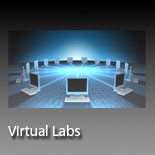Capabilities
Live Collaboration

Live Collaboration enables remote attendance of lectures, seminars, office hours maximally preserving the experience of in person attendance. Students have access to view the instructor and classroom environment, high fidelity view of whiteboard or computer screen images etc. , and a capability to ask questions and provide feedback in real time.
Benefits
Enables students to define their personal blend of in person and online attendance and self study while maintaining academic rigor and discipline.
Virtual Labs

Virtual Labs ensure fusion of academic knowledge, practical skills and workplace competencies. Students benefit from a shorter path to achieving educational benefits through career advancement, new employment opportunities, increased engagement and personal satisfaction. The latest virtualization technologies create opportunities to bring more case studies and real world scenarios into the educational process. Labs are designed based on the “see the whole picture” concepts and highlight end-to-end business processes to overcome the risks of developing a fragments vision due to sequential module-based teaching.
Benefits
MET Virtual Labs can be accessed with zero client setup from most of the end-user devices available today, including PC, MAC, Linux, iPad, Chromebook, Surface, iPhone, etc.
Handwriting Capture

Live handwriting can convey some learning much more effectively than even the most carefully prepared PowerPoint Presentation. It is important that we retain this mode of teaching in the virtual classroom. Handwriting solutions range from electronic capture of the traditional physical whiteboard, to wall mounted smart boards to desktop tablets and laptops. These solutions allow handwriting to be easily shared to remote learning captured clearly in a variety of recording formats, and saved as a PDF for distribution to students.
Benefits
Enables students to have a richer experience of the course content through recordings and remote class connection. Allows instructors to easily combine prepared course materials with live handwritten instruction.
Structured Content
Structure is a critical component of blended learning. By choosing a blended course format students are essentially asking for help in balancing their educational objectives with commitments outside of the university campus. An advanced course management system, together with a well-designed network of student and faculty support services, brings a solid structure into the learning process and becomes a critical factor in achieving systematic progress and high performance levels. The system provides a single point of access to organized course materials, learning activities, calendar, communication tools, grade information, etc.
All courses include built-in independent learning elements, supported by asynchronous communications through recorded lectures and seminars, pre-recorded tutorials, and just-in-time faculty commentary, for example, analysis of the latest course-related events or student performance feedback.
Benefits
With the increased emphasis on self-study in blended and online courses, clear organization of course materials and learning activities plays an important role in helping students to succeed. From the faculty perspective, well organized content saves time with lecture preparation, distribution of lecture notes and assignments, updating content, getting support from teaching assistants, rolling courses over to the next semester, etc. Organizing course content and learning activities using a course management system was always a part of online learning, but more and more on-campus courses start using these systems as well.


